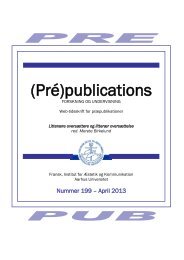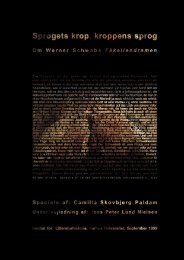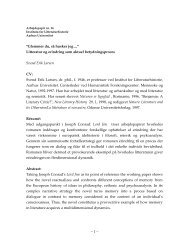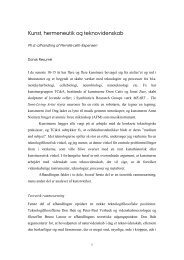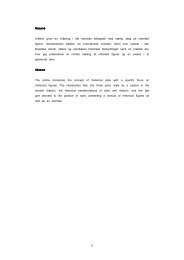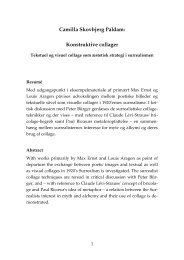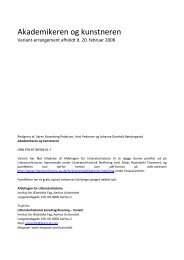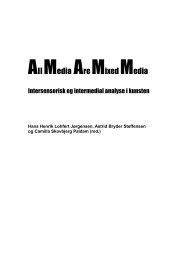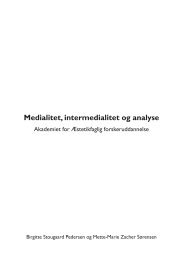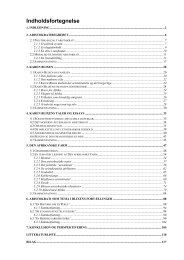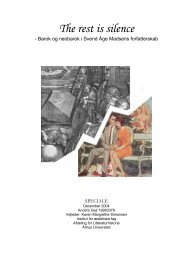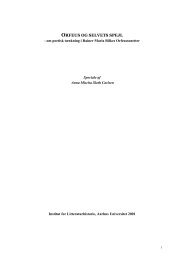Indhold Indledning - Institut for Æstetik og Kommunikation - Aarhus ...
Indhold Indledning - Institut for Æstetik og Kommunikation - Aarhus ...
Indhold Indledning - Institut for Æstetik og Kommunikation - Aarhus ...
You also want an ePaper? Increase the reach of your titles
YUMPU automatically turns print PDFs into web optimized ePapers that Google loves.
The topic of this paper, which is entitled ”Textural concealments – An<br />
investigation of transtextual topoi in Proust, Pamuk and Murakami”, is the<br />
relationship between Marcel Proust’s À la Recherche du temps perdu (1913-<br />
1927), Orhan Pamuk’s The Black Book (1990) and Haruki Murakami’s The<br />
Wind-Up Bird Cronicle (1997). My analysis will focus on identifying and<br />
characterizing the intertextual and hypertextual topoi related to existence and<br />
perception, which constitutes the novels’ protagonists’ identities. Hence, my<br />
reading will pursue a strategy, which does not emphasize nationality, genre<br />
and/or stilistic similarities, but rather the palimpsestic relationship between<br />
the novels, which will reveal itself through a series of detail readings of scenes<br />
involving certain topoi, which will then be put into the perspective of the<br />
relation between the subject and the object and the general intersubjective<br />
relations of modernity.<br />
The first chapter, which is entitled ”The beloved”, has three<br />
subdivisions. The first of these subdivisions, ”Imago”, is primarily concerned<br />
with the visual representation of the beloved other, that is the perception and<br />
rec<strong>og</strong>nition of the human body and the understanding of the subject as an<br />
interrelational, non-individualized agent. Above all the analysis will focus on<br />
the discrepancy between the actual physical being there of the other and the<br />
perceived distance between the subject and the object, the combination of a<br />
spatial here and a temporal then. In the second of the subdivisions, ”The<br />
voice”, the analysis will focus on the auditive representation of the other as it<br />
manifests itself in the telephonic contact, which place the presence of the other<br />
in a spatial there and a temporal now. The third of the subdivisions, ”The<br />
writing”, deals with the complex scriptural relation between the protagonist<br />
and the disappeared woman, hence the occultation of the presence of the<br />
other resulting in the combination of a spatial there and a temporal then.<br />
The second chapter, which is entitled ”The other and (the being of) the<br />
world”, has two theoretical foci: the phenomenol<strong>og</strong>ical investigations by<br />
Maurice Merleau-Ponty, which is based on a general conception of the body<br />
71




